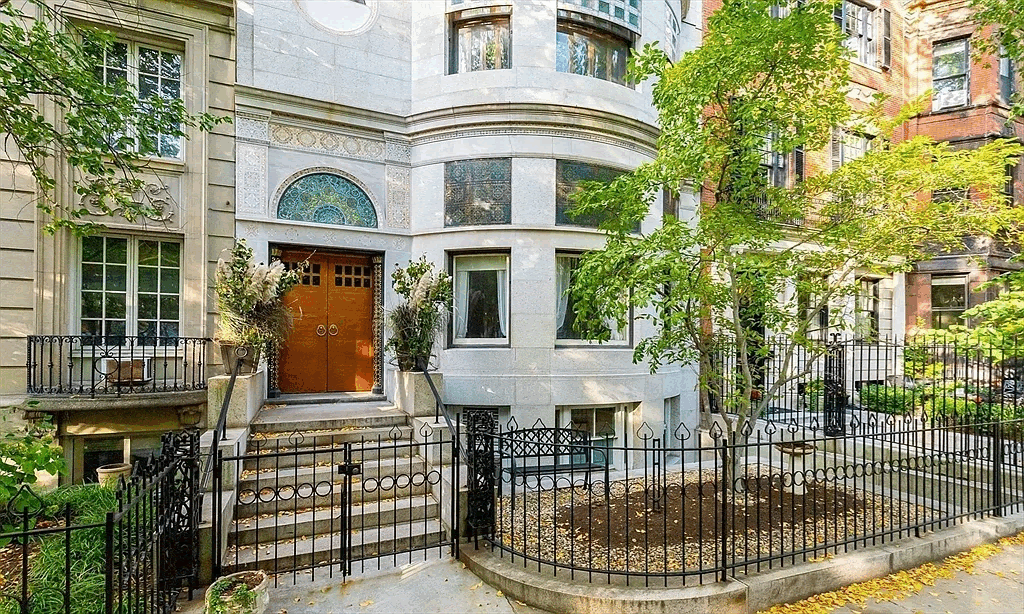An Architectural Symphony
Approaching the mansion, one is immediately struck by the shimmering glass mosaics on the exterior, a rare feature in American residential architecture. These mosaics, along with intricate stone carvings and decorative ironwork, transform the building into a monumental jewelry box. The play of light on these surfaces throughout the day evokes the shifting hues of a stained-glass window.
Once inside, the mansion reveals an even more astonishing array of decorative art. The sweeping staircase adorned with iridescent tiles, the richly ornamented ceilings, and the commanding stained-glass windows each reveal Tiffany’s genius for merging form with function.
The interior also celebrates natural light as a design element, with strategically placed skylights and windows designed to create a dynamic, changing atmosphere. During the day, sunlight dances across mosaic panels and glass details, while at night, the home transforms under the warm glow of carefully placed fixtures, many of them original to the property.
Luxury Beyond Compare
Today, the Ayer Mansion offers an astonishing 23 bedrooms and 12 bathrooms, making it one of the most expansive private residences in Boston. Five grand fireplaces anchor the main living spaces, each showcasing artisanal tiles and elaborate mantels — works of art in their own right.
This is not simply a house to live in; it is a house to inhabit as an immersive experience. Every detail invites contemplation and admiration. The parquet floors, the carved moldings, the intricate stair railings — each bears witness to a commitment to craftsmanship nearly impossible to replicate today.
For residents and guests alike, daily life in the Ayer Mansion feels akin to wandering through a private museum. Indeed, living here grants more than luxury and space; it offers the unparalleled bragging rights of dwelling within an architectural masterpiece, lovingly preserved over a century.
A Testament to the Gilded Age
The mansion is a rare surviving example of the Gilded Age’s opulent spirit, a period in American history marked by explosive industrial growth and extravagant personal fortunes. Yet, what distinguishes the Ayer Mansion is its artistic ambition. While other Boston mansions were designed in various revivalist styles to mimic European aristocracy, Ayer’s collaboration with Tiffany represented a distinctly American creative voice.
In that sense, the mansion is not just a symbol of wealth, but of cultural evolution. It reflects an era when American patrons began to support homegrown talent and to define a national aesthetic distinct from Old World precedents. Tiffany’s work at the Ayer Mansion helped pave the way for the emergence of American Art Nouveau and cemented his place as a pioneer of design.
Amenities for a Modern Collector
Despite its historic pedigree, the Ayer Mansion caters to modern luxury expectations. Four private parking spaces in the heart of Back Bay — an impossible find in Boston’s dense urban landscape — grant unparalleled convenience. Multiple kitchens, formal dining rooms, and grand entertaining areas make the home as functional as it is magnificent.
Technology and discreet modern upgrades coexist harmoniously with the original features, ensuring comfort without compromising authenticity. In this way, the mansion respects its heritage while accommodating contemporary lifestyles, a balance few historical properties manage to achieve.
Stained Glass and Storytelling
Central to the mansion’s magic is Tiffany’s mastery of stained glass. More than mere decoration, these windows tell stories in color and light. Each panel is meticulously crafted to create depth and motion, turning ordinary sunlight into a living painting that shifts with the hour and season.
The technique, known as “Favrile” glass, was pioneered by Tiffany to create richly colored, opalescent effects that could not be achieved through traditional painting. In the Ayer Mansion, these windows function like jewels set into an elaborate crown — luminous, captivating, and deeply personal.
Visitors often remark that the stained glass alone could stand as a museum collection. For the fortunate resident, however, these windows are part of daily life: a morning coffee enjoyed in a sunlit room becomes an encounter with living art.
Mosaics and Mosaic Thinking
Beyond the glass, the mansion’s mosaics represent Tiffany’s dedication to detail and his ability to unite diverse elements into a unified whole. On walls, stair risers, and even ceilings, thousands of tiny tiles create abstract and figurative compositions.
This mosaic thinking — seeing each small piece as critical to the integrity of the larger vision — mirrors Tiffany’s broader artistic philosophy. He believed that every detail mattered and that true beauty arose from the interplay of many parts. In today’s world of mass-produced finishes, this attention to micro-scale artistry feels particularly radical and inspiring.
A Legacy at Risk and Renewed
The Ayer Mansion has not always enjoyed the reverence it receives today. Throughout the 20th century, the property underwent changes in ownership and function, including stints as offices and dormitories. These adaptations threatened the integrity of Tiffany’s designs.
Thanks to advocacy from preservationists and the establishment of the Campaign for the Ayer Mansion, extensive restoration efforts have safeguarded and revived Tiffany’s original vision. Painstaking work has included cleaning and repairing mosaics, restoring glass panels, and replicating lost design elements using historical photographs and Tiffany’s own notes.
For architecture enthusiasts and historians, this is more than a private home — it is a case study in the possibilities of historic preservation and the resilience of true artistry.
Back Bay: A Historic Canvas
Situated in Boston’s Back Bay, the mansion’s neighborhood itself is a masterpiece of urban design. Created in the mid-19th century through an ambitious land reclamation project, Back Bay was intended to be Boston’s answer to Parisian boulevards. Wide avenues, uniform setbacks, and a mix of brownstone and brick townhouses created an elegant urban fabric that persists to this day.
Living on Commonwealth Avenue places one at the heart of Boston’s cultural, academic, and social life. From the nearby Boston Public Library and Copley Square to high-end boutiques on Newbury Street and green escapes in the Public Garden, the location offers an enviable blend of history and contemporary vibrancy.
For the future owner of the Ayer Mansion, this context enhances the allure: to possess a house of unrivaled artistic pedigree set within one of America’s most beautiful and dynamic urban neighborhoods.
A Residence or a Responsibility?
Owning the Ayer Mansion is not for the faint of heart. More than a real estate transaction, it is an act of stewardship. The new owner steps into a lineage of care that extends beyond personal comfort to the guardianship of a national treasure.
Yet, for the right buyer — someone with an eye for art, a reverence for history, and a passion for living beautifully — the mansion promises a lifestyle unlike any other. To wake up under a Tiffany ceiling, to host dinners beside iridescent mosaics, to watch the seasons dance across stained-glass windows: this is a daily immersion in art at its highest level.
Conclusion: The Ultimate Boston Address
In a market crowded with luxury listings boasting rooftop terraces and smart home systems, the Ayer Mansion stands apart. It offers not merely luxury, but legacy. Not just space, but story.
Here, the phrase “amenities” transcends the usual list of marble bathrooms and chef’s kitchens. Instead, it encompasses mosaics designed by one of America’s greatest artists, light filtered through iridescent glass, and the knowledge that one lives inside a unique expression of American creativity.
With its 23 bedrooms, 12 bathrooms, five fireplaces, four parking spaces, and countless stories etched into glass and stone, the Ayer Mansion is a living testament to the power of art to shape not just spaces but lives.
For the discerning collector, aesthete, or dreamer, this is not just a home — it is a chance to live inside a legend.
No comments yet.









